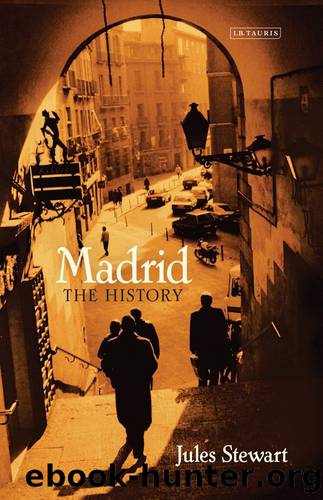Madrid: The History by Jules Stewart

Author:Jules Stewart [Stewart, Jules]
Language: eng
Format: epub
Tags: Spain, General, Architecture, Literary Studies, Social and Cultural History, Travel, European history, Travel and Holiday, Europe, History of Art, History, Spain & Portugal
ISBN: 9781780762814
Google: TQbQo7lraQoC
Amazon: B00D5RGQWG
Goodreads: 15794269
Publisher: I.B.Tauris
Published: 2012-01-01T00:00:00+00:00
The Aranjuez line was dubbed âel Tren de la Fresaâ (âthe Strawberry Trainâ), as a result of Aranjuezâs famous April strawberry harvest, something that was to have an impact on transporting goods and people to and from the capital. âThis new mode of transport even influenced Madrileñosâ diet, by gradually bringing fresh food to the city as a substitution for salted produce.â20
Why the first railway line from Madrid was laid between the capital and this relatively insignificant royal resort, and not between Madrid and Toledo or Valladolid, for instance, could perhaps be explained by an analogy with the countryâs first long-distance, high-speed train (Alta Velocidad Española, AVE), which entered into service between Madrid and Sevilla in 1992. The more logical link in terms of passenger and cargo volume would have been Barcelona, or France via Irún. In other words, if travellers can get from Madrid to Sevilla in two and a half hours, does it make sense to have to spend up to six hours on a train from Madrid to Barcelona? As the socialist PSOE prime minister Felipe González confided unofficially at the time, if the government had done the âlogicalâ thing, they would have faced great difficulties raising the funds and political support for extending the network to less heavily trafficked destinations, such as Sevilla.
On a February morning in 1851, the streets around Atocha station were clogged with more than a thousand spectators, Madrileños as well as people from surrounding villages who had come to the capital to catch a glimpse of the smoke-belching monster pulling its load of distinguished passengers on the 75-minute journey south to Aranjuez. A great fête had been organised and paid for by the financier José de Salamanca, Marqués de Salamanca, one of the founders in 1847 of the operating company Sociedad del Ferrocarril de Madrid a Aranjuez, a venture-capital firm set up with 45 million reales in equity and which, three months after the first train departed Atocha station, was making a profit of 50,000 reales a day. The Archbishop of Toledo was on hand that morning to bless the garlanded locomotive, which was welcomed by an equally ecstatic crowd as it chugged up to the station that had been built for it at Aranjuezâs royal palace. Thirteen years later, in 1864, the first direct train from Paris arrived at Atocha station, the line having been built in less time than it took to complete the MadridâBarcelona high-speed link.
The advent of the railway entailed a radical change for Madrid, from its comfortable isolation in the middle of the Castilian plateau, âa predator of its own environment, inexplicably the court of an imperial monarchyâ,21 to a capital accessible from every city of the Spanish periphery. The concept of the Puerta del Sol as the centre of the world began to vanish, as the northâwest axis along the Paseo de la Castellana was extended and gradually took on the role of Madridâs gateway to the industrial ports of Bilbao and Santander to the north, and the great AndalucÃan cities of Sevilla, Granada and Málaga to the south.
Download
This site does not store any files on its server. We only index and link to content provided by other sites. Please contact the content providers to delete copyright contents if any and email us, we'll remove relevant links or contents immediately.
Spell It Out by David Crystal(36040)
Underground: A Human History of the Worlds Beneath Our Feet by Will Hunt(12022)
A Year in the Merde by Stephen Clarke(5323)
Venice by Jan Morris(2524)
Claridge's: The Cookbook by Nail Martyn & Erickson Meredith(2359)
My Paris Kitchen: Recipes and Stories by Lebovitz David(2255)
A TIME OF GIFTS by Patrick Leigh Fermor(2155)
The Plantagenets by Dan Jones(2039)
Welcome to the Goddamn Ice Cube by Blair Braverman(1990)
The Finnish Way by Katja Pantzar(1933)
Top 10 Prague (EYEWITNESS TOP 10 TRAVEL GUIDES) by DK(1929)
From Russia with Lunch by David Smiedt(1927)
Bang Poland: How To Make Love With Polish Girls In Poland by Roosh V(1921)
The Isle of Mull by Terry Marsh(1894)
A TIME TO KEEP SILENCE by Patrick Leigh Fermor(1863)
Rick Steves London 2018 by Rick Steves & Gene Openshaw(1822)
Insight Guides Experience Tokyo by Insight Guides(1814)
A Taste of Paris by David Downie(1811)
Merde in Europe by Stephen Clarke(1726)
